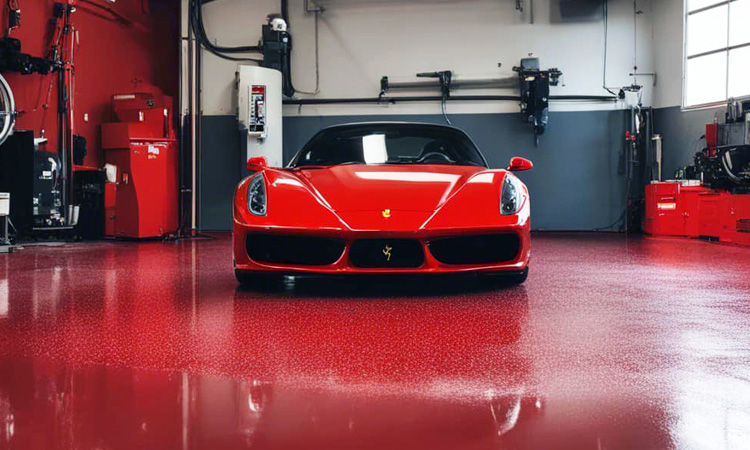Concrete Res has more than 25 years of experience, deeply experienced team leads and installers, dedicated project management, and flexibility!
Epoxy Floors
Epoxy floors are very durable for most commercial and industrial applications. Additional durability can be achieved by adding more layers to the system. A four layer epoxy system is more durable to dropped tools and damage than a three layer system. For heavier duty applications, urethane cement provides a heavier duty floor.
It’s nearly endless! It all comes down to a quality product (we work directly with the manufacturers) and skill in application (our team leads have each been with Concrete Res for more than 15 years). Click here to see our flake options and here to see examples of our metallic installs.
Epoxy flooring is known for its durability, chemical resistance, and easy maintenance. It is also available in a wide range of colors and patterns, and can be customized to meet the specific needs of a space.
Epoxy flooring can be used in a variety of settings, including industrial warehouses, retail stores, hospitals, manufacturing settings, schools and more. It is a popular choice for areas that experience heavy foot traffic or equipment use, as it can withstand wear and tear.
Epoxy flooring is a type of flooring that is made by mixing a two-part resin system, which includes epoxy resin and a hardener. This mixture is then applied to a prepared surface, where it cures and creates a hard, durable surface.
Epoxy, urethane cement and polyaspartic floors can all be installed with varying degrees of non-slip properties to meet the objectives of your project. Quartz sand can be broadcast in different quantities from none to quite a lot. This aggregate adds lots of grip into the floor. Different sized quartz aggregates can further enhance non-slip characteristics. For intense non-skid applications where traction is a must, we can even broadcast aluminum oxide which are actual metal granules into the floor.
For most people, epoxy flooring has become synonymous with the broader category of resinous floors. What many don’t realize is that within this catch all of “epoxy” there is a whole family of many products that may appear similar however have many different qualities. Epoxy falls short when it comes to high or very low temperature applications, for example in walk-in freezers or when exposed to very hot water in a commercial kitchen. It also isn’t the best choice when it will be exposed to a significant amount of prolonged water. Lastly, when chemical resistance is necessary, other resinous flooring options often are a better choice.
As little as one day! That said, do not use a company who rushes the work. Taking the time to get the job done right will help you enjoy your floor for years to come!
Epoxy flooring is relatively easy to maintain. It can be cleaned with a mop and mild detergent, and any spills or stains can be wiped up with a clean cloth. In large areas, an autoscrubber can be used to quickly and efficiently clean epoxy floors. Avoid using harsh chemicals or abrasive cleaners, as these can damage the surface.
Yes, epoxy flooring can be repaired if it becomes damaged. Small cracks or chips can be filled in with an epoxy repair kit, while larger repairs can but cut out and reinstalled. Repairs shouldn’t be expected to perfectly match, but can still look great with minimal change to the floor in the repaired area.
With proper maintenance, epoxy flooring can last for many years. In some cases, it can last for up to 20 years or more.
Epoxy flooring is considered to be a relatively environmentally friendly flooring option, as it is low in volatile organic compounds (VOCs) and can be recycled at the end of its life.
Polished Concrete
Concrete polishing is a process of smoothing and shining concrete surfaces using a series of progressively finer diamond abrasives. It is often used to enhance the appearance of floors in commercial and industrial settings.
Polished concrete floors are highly durable, easy to maintain, and have a high-end, modern look. They are also environmentally friendly and can help reduce energy costs by reflecting light and heat.
Polished concrete can be used in a variety of settings, including retail stores, warehouses, showrooms, and office buildings. It is often used in high-traffic areas where durability is important.
Not all concrete surfaces are suitable for polishing. The surface must be in good condition, with no major cracks, damage or level changes. Additionally, the surface must be flat and level, with no major variations in height. Much of these issues can be resolved with proper surface prep and in some cases added fillers or grout.
Polished concrete is relatively easy to maintain. It can be cleaned with a mop and mild detergent, and any spills or stains can be wiped up with a clean cloth. Avoid using harsh chemicals or abrasive cleaners, as these can damage the surface. For large areas, a walk behind or ride-on autoscrubber can dramatically reduce cleaning times and increase efficiency.
With proper maintenance, polished concrete can last for many years. In some cases, it can last more than 20 years. When the surface begins to eventually dull, it’s luster can typically be restored by burnishing the floor with a diamond impregnated pad.

